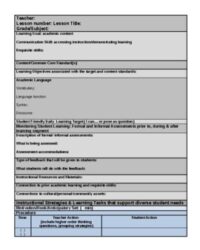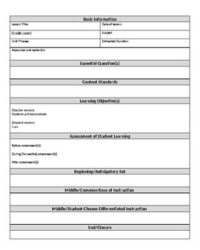Navigating the journey to becoming a certified teacher in California involves several significant hurdles, and one of the most prominent is the edTPA. This performance-based assessment requires you to demonstrate your teaching skills through a series of tasks, and at the heart of it all lies the meticulously crafted lesson plan. For many aspiring educators, understanding how to structure and articulate their instructional design within the specific framework of the edTPA can feel like a complex puzzle. It’s not just about what you teach, but how you plan for it, adapt to student needs, and assess learning.
The good news is that while the edTPA is rigorous, it’s also a highly structured process designed to ensure you’re prepared for the realities of the classroom. Focusing on a well-understood lesson plan template tailored to the California context can significantly streamline your efforts, allowing you to concentrate on the substance of your teaching rather than getting bogged down by formatting or overlooked requirements. This article aims to demystify the process, offering insights into how you can effectively utilize and adapt an edTPA lesson plan template to meet the demands of this crucial assessment.
Navigating the edTPA Lesson Plan Requirements for California Educators
The edTPA lesson plan isn’t merely a blueprint for a single class session; it’s a comprehensive demonstration of your pedagogical reasoning and readiness to teach diverse learners. For California educators, this means aligning your plans with state standards like the California Common Core State Standards (CCSS), Next Generation Science Standards (NGSS), and the California English Language Development Standards (CA ELD Standards). The assessors are looking for evidence that you can design instruction that is standards-aligned, addresses academic language, differentiates for various student needs, and includes appropriate assessments. It’s a holistic view of your teaching prowess, from initial planning to reflecting on student learning.
Your lesson plans within the edTPA context serve as the foundation for Task 1: Planning for Instruction and Assessment. This task requires you to describe your context for learning, develop objectives, design engaging learning tasks, plan for differentiation, and outline how you will assess student understanding. Each element must be explicitly connected, demonstrating a coherent and thoughtful approach to teaching. It’s a cyclical process of planning, teaching, assessing, and then reflecting, with the lesson plan acting as your initial roadmap.
Understanding the specific rubrics for your subject-specific edTPA handbook is crucial. While general lesson plan elements are universal, the emphasis and detail required for academic language, for instance, might vary slightly depending on whether you’re teaching English Language Arts, Mathematics, or Science. This is where a robust edTPA lesson plan template comes into its own, providing a structured framework that prompts you to consider all necessary components, ensuring nothing is overlooked in your planning.
A common challenge is making sure your lesson plans clearly articulate not just what students will learn, but how they will learn it, and why those particular strategies are appropriate for your specific learners. This requires deep reflection on your students’ prior knowledge, their cultural backgrounds, and any specific learning needs. It’s about showing that you can be responsive and intentional in your instructional design, moving beyond a generic plan to one that truly serves your unique classroom environment.
Key Components of an Effective edTPA Lesson Plan
When developing your lesson plans for the edTPA, ensure you meticulously address these critical areas. Each component needs to be thoughtfully considered and clearly articulated to demonstrate your understanding of effective instructional design.
- **Learning Objectives:** These must be measurable and clearly state what students will know or be able to do by the end of the lesson. They should align directly with state standards.
- **Academic Language Demands:** Identify the specific vocabulary, syntax, discourse, and functions students will need to use to engage with the lesson content. Plan explicit supports for these demands.
- **Instructional Strategies and Learning Tasks:** Detail the sequence of activities, teaching methods, and student engagement strategies. How will you introduce content, facilitate learning, and provide opportunities for practice?
- **Differentiation and Scaffolding:** Describe how you will support the diverse needs of your learners, including English language learners, students with special needs, and advanced learners. What scaffolds or extensions will you provide?
- **Assessments (Formative and Summative):** Explain how you will monitor student learning throughout the lesson and how you will formally assess their understanding at the end. How will these assessments inform your instruction?
Tailoring Your Lesson Plan to Your edTPA Context
Your edTPA lesson plans are not generic. They must be deeply rooted in the specific context of your teaching placement, your particular students, and the curriculum you are teaching. This means considering the grade level, subject matter, and the unique characteristics of your students, including their prior knowledge, strengths, and challenges.
It is vital to integrate relevant California state standards explicitly. For example, if teaching a middle school science lesson, referring to specific NGSS performance expectations and connecting your objectives to them is paramount. Similarly, for English Language Arts, referencing CCSS standards and explaining how your activities build towards them is essential. This contextualization demonstrates your ability to plan instruction that is relevant, rigorous, and responsive to the educational landscape of California.
Strategies for Efficient edTPA Lesson Plan Template California Adaptation
Successfully completing the edTPA often comes down to efficient planning and effective use of available resources. When it comes to the edTPA lesson plan template California candidates might use, it’s not about simply filling in blanks. Instead, think of it as a robust framework that helps you organize your thinking and ensure you’ve addressed all the required elements. The real skill lies in adapting the template to reflect your unique teaching context and the specific learning segment you’ve chosen for your edTPA submission.
One of the most effective strategies is to begin with the end in mind. Before diving into the specifics of each lesson, clearly define your learning objectives and the corresponding assessments. This “backward design” approach ensures that every activity and instructional decision serves a clear purpose, directly leading students toward the intended learning outcomes. It also helps in identifying the academic language demands and planning for differentiation more effectively, as you already know what knowledge and skills students need to master.
Leveraging resources provided by your university or credentialing program is also invaluable. Many institutions offer their own versions of an edtpa lesson plan template california educators can use, often with embedded prompts or guiding questions that align with the edTPA rubrics. Utilize these templates as a starting point, but always customize them to fit your teaching style and the nuances of your specific learning segment. Discussing your plans with your cooperating teacher or university supervisor can also provide critical feedback, helping you refine your plans before submitting your final portfolio.
Here are some actionable steps to make the most of your lesson planning:
- **Start with your edTPA Handbook:** Always refer back to your specific subject handbook for the precise requirements and rubrics related to lesson planning.
- **Leverage University Resources:** Many universities offer workshops, sample templates, and dedicated edTPA support staff. Take advantage of these resources.
- **Collaborate and Seek Feedback:** Discuss your lesson plans with peers, mentors, and cooperating teachers. Fresh perspectives can highlight areas for improvement.
- **Focus on Clarity and Coherence:** Ensure that your lesson plan flows logically and that all components are clearly articulated and interconnected.
- **Practice and Refine:** The edTPA is an iterative process. Plan, teach (or imagine teaching), reflect, and revise your plans based on what you learn.
Mastering the art of edTPA lesson planning is more than just a requirement for certification; it’s a foundational skill for a successful teaching career. By thoughtfully constructing your lesson plans, you’re not only demonstrating your readiness for the edTPA, but also developing a crucial competency in designing instruction that genuinely supports all learners. The process compels you to think critically about every aspect of teaching, from setting clear objectives to differentiating instruction and assessing understanding, preparing you for the dynamic challenges of the classroom. While the edTPA can feel daunting, approaching the lesson planning component with a strategic mindset and utilizing a well-adapted template transforms it from a hurdle into a valuable learning experience that will serve you well for years to come.


